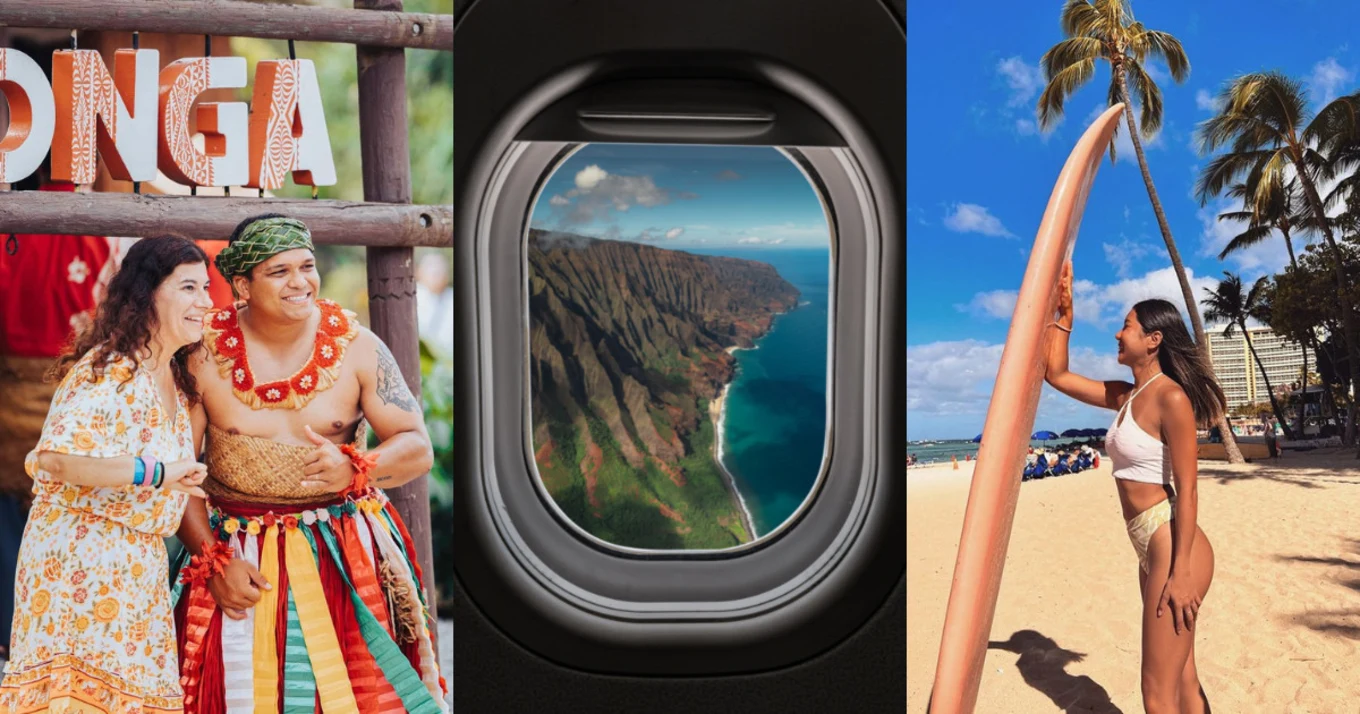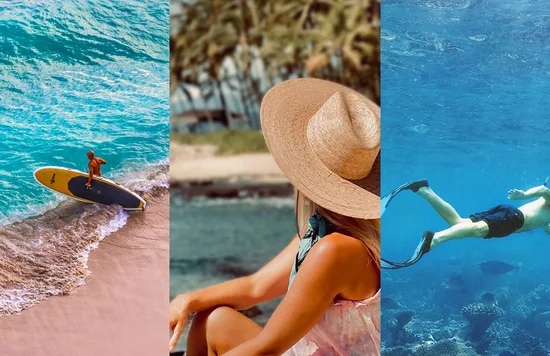Aloha! We all know Hawaii for its laid-back vibes, vibrant culture, and fantastic coastlines—there are heaps of things that make this tropical paradise a must-visit on travellers' bucket lists.
Are you going to Hawaii for the first time? With all the places to explore in Hawaii, are you stuck figuring how to start planning your holiday? There’s a lot to consider when visiting Hawaii for the first time: from planning your itinerary to learning basic etiquette to checking out the Hawaii weather.
But don’t stress, we’re here to give you the rundown on all you need to know about Hawaii: weather, the dos and don’ts, and everything in between:
What is Hawaii famous for?
1. Breathtaking landscapes
2. Surf scene
3. Vibrant culture
When is the best time of the year to go to Hawaii?
4. Hawaii weather
5. Know when is the best time to visit Hawaii
What is the culture like in Hawaii?
6. Respect Hawaiian culture
7. Learn a few basic local words
8. Know your ‘okina
9. Steer clear from Kapu
10. Remember: not everyone is Hawaiian
What to do and what not to do in Hawaii
11. The dos
12. The don’ts
Is there a dress code in Hawaii?
13. Underdressing is the key
What else should I keep in mind?
14. Book in advance
15. Be aware of floods
16. Know where to surf
17. Love the view? Pull over!
18. Splurge on food
What is Hawaii famous for?
1. Breathtaking landscapes
It’s a no-brainer that Hawaii makes for the perfect postcard, thanks to its 1200 kilometres of dreamy tropical landscapes and spotless coastlines dotted with volcanoes. It is also home to eight pristine islands— tourists can visit six of them! Unfortunately, you can’t drive from one island to another, making it a lil tricky to go on an island hopping road trip. For first-timers, we recommend going to Oahu!
2. Surf scene
The perfect combo of Hawaii weather, ideal waves, and chill culture make the Aloha State famous for its surf scene. It originated as “wave sliding” and was considered much more than a recreational hobby or extreme sport. Ancient Hawaiians integrated surfing into their culture, especially keeping their influential leaders in tiptop shape.
3. Vibrant culture
Do you also think of hula dance and luaus when you talk about Hawaii? Hawaiian culture is based on legends, myths, and superstitions. Among these traditions include the custom of gifting and wearing a lei (except when you’re pregnant), the expression of aloha (which means being in the presence of and sharing the essence of life), and high-spirited music called hapa-haole and kolohe. Hawaii is also known for its rich cuisine, which gave us poke bowls.
When is the best time of the year to go to Hawaii?
4. The two seasons that make up Hawaii’s weather
Hawaii's weather is made of two seasons. There is summer, or kau, which happens from May to October, and winter, or ho'oilo, from November to April.
5. When should I visit Hawaii for good weather?
Hawaii’s lucky enough to have fantastic weather is all year round, which means any time’s a good time to travel to Hawaii Of course, you should expect it to get a bit hotter during the summer and see rain more frequently during the winter.
If you want to escape the crowds and save a few bucks on your trip, Hawaii's off-peak season is from mid-September to mid-November and during the weeks right after Easter until the end of May.
What is the culture like in Hawaii?
6. Respect Hawaiian culture
Hawaiian culture is rooted in age-old stories and traditions. It’s part of their identity and heritage, so make sure to respect Hawaiian culture while you’re here. Observe lei etiquette and graciously accept the lei gifted to you upon arrival. If you're pregnant, wear an open or untied lei, where the sides hang from your shoulder, as it is considered bad luck if you wear it closed or tied.
7. Learn a few basic local words
As with visiting other countries, learning a few local words can be helpful, especially if you're visiting for the first time. Aside from showing appreciation for the service you received from locals, it also shows your respect for their culture. Some words to learn before your flight are aloha (hello and goodbye), mahalo/mahalo nui loa (thank you/thank you very much), and aloha wau ia 'oe (I love you).
Did you know? The Hawaiian language, Ōlelo Hawai'i, arrived on Hawaiian shores with the first people from Polynesia's original homelands.
8. Know your ‘okina
While in Hawaii, try your best to pronounce all the places' names correctly. One standard mark in these names is the 'okina or the Hawaiian language's glottal stop. This punctuation mark is significant as it determines the pronunciation and meaning of words. For example, the Hawai'i with the 'okina is used for the Big Island, which refers to ancient Hawai'i, while Hawaii without the 'okina refers specifically to the US state.
9. Steer clear from Kapu
While exploring the islands, you might encounter signs that read Kapu. This sign, which means Keep Out, is usually used for sites that are ancient burial grounds or sacred meeting places. You are encouraged to honour this custom and refrain from trespassing these lands.
10. Remember: not everyone is Hawaiian
Did you know there's a difference between a Hawaiian and a local? When someone is called a Hawaiian, they are of Hawaiian descent, regardless of whether they're born or raised in Hawaii. Only 9% of the state's population are considered true Hawaiians.
When you call someone a local, that means they are not of Hawaiian descent but were born in the state or had been living there for a few years.
What to do and what not to do in Hawaii
Wanna avoid any faux pas on your first visit to Hawaii? Here are a few basic dos and don’ts you should follow:
11. The dos
- Use aloha and mahalo. Don't forget to use and wave the shaka or the hang loose gesture.
- Try to pronounce Hawaiian names and words accurately. You could ask your guide or someone living in the state for pronunciation tips.
- Unless you're fluent in the native language, better stick to using English and the essential words you learned.
- Self-driving? Drive slowly! Residents tend to drive slower, thanks to their laid-back vibes, so it's best to follow them.
12. The don’ts
- Maui, Kauai, Molokai, Lanai, and Hawai'i aren't outer islands—avoid referring to them as this. Call them Neighbour Islands instead.
- Don't collect stones and lava or stack rocks when visiting nature spots and sacred sites. It is considered littering and is a huge no-no in the islands.
- Don't scream when you see a critter. Hawaii is in the tropics, so expect a few gecko and cockroach sightings while you're here.
- Don't get topless on the beach. Although there are some unofficial clothing-optional beaches in Hawaii, it's best to check if there are residents who are already topless before you do!
Is there a dress code in Hawaii?
13. Underdressing is the key
Hawaii has no strict dress code, but it's better to dress casually. T-shirts and thongs are the way to go, especially since you'll spend most of your time outdoors, on the beach or in nature.
Going fancy means opting for a neat, modest attire if you're visiting a high-end restaurant. No need for black-tie clothes—an aloha shirt and slacks would suffice for men, and casual summer or maxi dresses for women.
What else should I keep in mind?
14. Book in advance
While their hang-loose attitude may make you want to do everything in Hawaii spontaneously, we highly suggest you book ahead for your trip to Hawaii. It's always best to plan your flight tickets, hotel, restaurant reservations, and attraction tickets in advance. Almost always, you get cheaper prices when you book ahead!
15. Be aware of floods
During wintertime, Hawaii may see more rainy days than usual, and a sudden rainstorm can cause a flash flood. Check the weather advisory before heaPractise your surf skills while you’re here. Credits: @tanmadonnas
ding out if you're in the Aloha State during the winter months and are planning to hike or swim in waterfalls.
16. Know where to surf
Since surfing is also considered sacred in Hawaii, some surf grounds are not open to the public. Still, there are surf spots that have become popular tourist destinations. Among these are Ehukai Beach Park in Oahu, Honolua Bay in Maui, and Kiahuna Beach in Kauai.
Also, watch out for box jellyfish when surfing! They are often seen in shallow waters seven to ten days after a full moon, closing some public beaches for everyone's safety.
17. Love the view? Pull over!
Going on a Hawaiian road trip? There are heaps to see outside your window, from lush panoramic views to overlooking ocean cliffs, since roads and highways are built on elevated lands. To show respect to other drivers on their daily commute, pulling over to the side of the road is customary before taking a photo. It is safer than rubbernecking while driving just to catch a glimpse of the view. Plus, your pics would turn out better and less blurry than when you take it on the road.
18. Splurge on food
What's a vacay without feasting on local food, right? While in Hawaii, make sure to splurge on extra fresh sashimi, Spam Musubi, Loco Moco, and poke bowls. Cool down with shaved ice! Need help with souvenirs? Kona coffee, macadamia nuts, and pineapple will help bring you a little piece of Hawaii back home.
Written by: Elle David


















![[Updated] Complete List Of Official Nationwide MCO SOP 2021](https://res.klook.com/image/upload/fl_lossy.progressive,q_85/c_fill,w_160,h_104/v1633858858/blog/iso56uzsphmdguixkvzh.webp)





![[Updated] Complete List Of Official Nationwide MCO SOP 2021](https://res.klook.com/image/upload/fl_lossy.progressive,q_85/c_fill,w_410,h_264/v1633858858/blog/iso56uzsphmdguixkvzh.webp)







